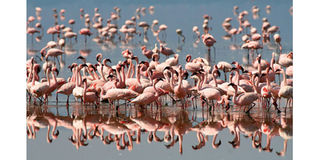Prime
Tanzania’s Flamingos among World’s most sought-after wildlife experiences

What you need to know:
- A study by JR Pass, which analysed global search volumes and social media engagement, placed Tanzania’s Lesser Flamingos at Lake Natron second on the list of the most sought-after animal encounters worldwide—only behind Thailand’s famous long-tailed macaques on Ko Phi Phi Don’s Monkey Beach.
Dar es Salaam. Tanzania’s shimmering flocks of flamingos at Lake Natron have captured global imagination, ranking among the top 10 most searched-for wildlife experiences in the world in 2025, according to new data released ahead of World Nature Conservation Day on July 28.
A study by JR Pass, which analysed global search volumes and social media engagement, placed Tanzania’s Lesser Flamingos at Lake Natron second on the list of the most sought-after animal encounters worldwide—only behind Thailand’s famous long-tailed macaques on Ko Phi Phi Don’s Monkey Beach.
With 39,000 monthly searches and tens of thousands of Instagram posts showcasing their dazzling pink plumage, the flamingos’ surreal presence in the caustic waters of Lake Natron has become a bucket-list attraction for eco-tourists and photographers alike.
Over one million Lesser Flamingos migrate to the lake each year, making it the world’s largest breeding ground for the species. The lake’s extreme alkalinity—so toxic it can burn human skin—makes it inhospitable to predators, providing a safe haven for flamingos to nest and hatch their young. These inhospitable conditions, however, only add to the site’s mystique and allure.
“This spectacle of nature, which was famously featured in Sir David Attenborough’s Planet Earth II, is a prime example of Tanzania’s unmatched natural heritage,” said an ecologist and conservationist. “It’s not just about the birds—it’s about the fragile, almost alien ecosystem that supports them.”
Wildlife tourism on the rise
The global fascination with natural encounters like Tanzania’s flamingos reflects a larger trend in travel. Wildlife tourism is booming, growing at an annual rate of 5.2 percent as more travelers seek meaningful, nature-based experiences—a trend often referred to as “biophilia travel.”
Across the top ten rankings, several animal encounters from around the world stood out for their unique cultural significance, ecological importance, and visual allure.
Leading the list is Ko Phi Phi Don’s Monkey Beach in Thailand, which draws an impressive 68,000 monthly searches and has been tagged in over 182,000 Instagram posts.
Whale and dolphin watching in the Azores, Portugal, ranked third, offering travelers a chance to observe marine life in its natural Atlantic habitat. In fourth place are the wild yet iconic feral ponies of Assateague Island in the United States.
Completing the top five are Japan’s revered and bowing Sika deer at Nara Park, known for their polite interactions with visitors and deep cultural symbolism.
Other popular experiences featured in the top 10 include swimming pigs in the Bahamas, cuddly koalas in Australia, and even butterflies in Texas.
With Lake Natron hosting 75 percent of the global Lesser Flamingo population, conservationists stress the importance of protecting this delicate habitat from threats like pollution, unsustainable tourism, and proposed upstream hydropower projects that could alter the lake’s water chemistry.
The growing visibility of Tanzania’s flamingos on social media and global search engines is helping to raise awareness about both their beauty and vulnerability.
As World Nature Conservation Day approaches, experts hope this renewed interest will translate into stronger commitments to habitat preservation and sustainable tourism across East Africa and beyond.





